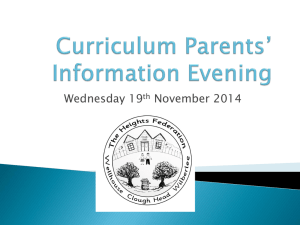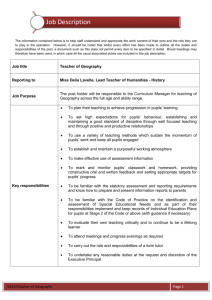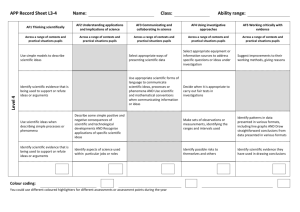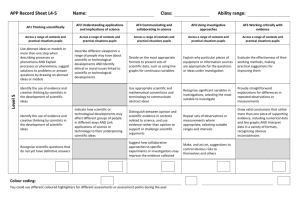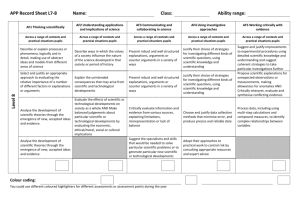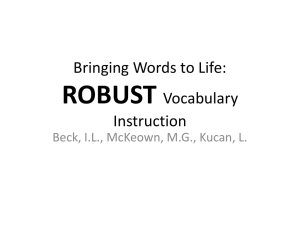Ancient Civilisations Immersion
advertisement
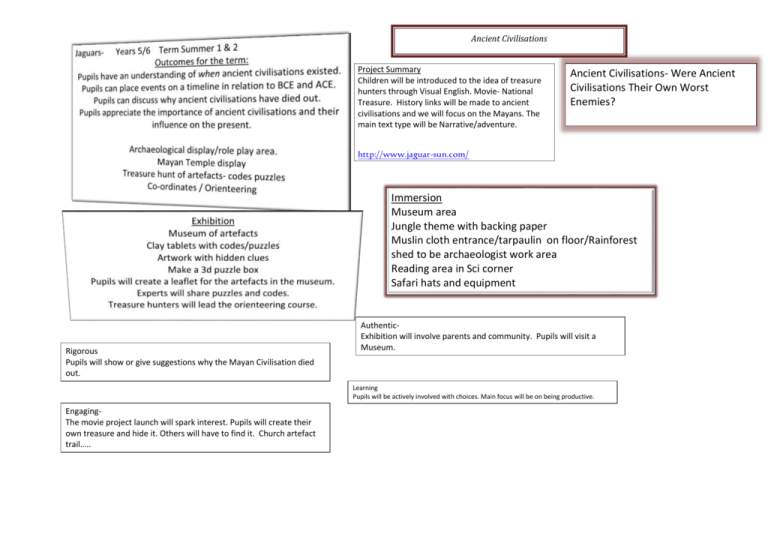
Ancient Civilisations Project Summary Children will be introduced to the idea of treasure hunters through Visual English. Movie- National Treasure. History links will be made to ancient civilisations and we will focus on the Mayans. The main text type will be Narrative/adventure. Ancient Civilisations- Were Ancient Civilisations Their Own Worst Enemies? http://www.jaguar-sun.com/ Immersion Museum area Jungle theme with backing paper Muslin cloth entrance/tarpaulin on floor/Rainforest shed to be archaeologist work area Reading area in Sci corner Safari hats and equipment Rigorous Pupils will show or give suggestions why the Mayan Civilisation died out. AuthenticExhibition will involve parents and community. Pupils will visit a Museum. Learning Pupils will be actively involved with choices. Main focus will be on being productive. EngagingThe movie project launch will spark interest. Pupils will create their own treasure and hide it. Others will have to find it. Church artefact trail….. WRITING . Narrative Non-fiction Poetry • Write stories setPin places pupils have been. • Write stories that contain mythical legendary or historical characters or events. • Write stories of adventure. • Write stories of mystery and suspense. • Learn by heart and perform a significant poem. • Write haiku. • Write cinquain. • Write poems that convey an image (simile, word play, rhyme and metaphor). READING Read and listen to a wide range of styles of text, including fairy stories, myths and legends. • Listen to and discuss a wide range of texts. • Learn poetry by heart. • Increase familiarity with a wide range of books, including myths and legends, traditional stories, modern fiction, classic British fiction and books from other cultures. • Take part in conversations about books. • Learn a wide range of poetry by heart. • Use the school and community libraries. • Look at classification systems. • Look at books with a different alphabet to English. • Read and listen to whole books. COMMUNICATION Engage in meaningful discussions in all areas of the curriculum. • Listen to and learn a wide range of subject specific vocabulary. • Through reading identify vocabulary that enriches and enlivens stories. • Speak to small and larger audiences at frequent intervals. • Practise and rehearse sentences and stories, gaining feedback on the overall effect and the use of standard English. • Listen to and tell stories often so as to internalise the structure. • Debate issues and formulate well-constructed points. Art and Design • Use experiences, other subjects across the curriculum and ideas as inspiration for artwork. • Develop and share ideas in a sketchbook and in finished products. • Improve mastery of techniques. • Learn about the great artists, architects and designers in history. MATHEMATICS •Count and calculate in increasingly complex contexts, including those that cannot be experienced first hand. • Rigorously apply mathematical knowledge across the curriculum, in particular in science, technology and computing. • Deepen conceptual understanding of mathematics by frequent repetition and extension of key concepts in a range of engaging and purposeful contexts. • Explore numbers and place value so as to read and understand the value of all numbers. • Add and subtract using efficient mental and formal written methods. • Multiply and divide using efficient mental and formal written methods. • Use the properties of shapes and angles in increasingly complex and practical contexts, including in construction and engineering contexts. • Describe position, direction and movement in increasingly precise ways. • Use and apply measures to increasingly complex contexts. • Gather, organise and interrogate data. • Understand the practical value of using algebra. CREATIVE DT • use research and develop design criteria to inform the design of innovative, functional, appealing products that are fit for purpose, aimed at particular individuals or groups. • generate, develop, model and communicate their ideas through discussion, annotated sketches, cross-sectional and exploded diagrams, prototypes, pattern pieces and computer-aided design. Make • select from and use a wider range of tools and equipment to perform practical tasks, such as cutting, shaping, joining and finishing, accurately. • select from and use a wider range of materials and components, including construction materials, textiles and ingredients, according to their functional properties and aesthetic qualities. Evaluate • investigate and analyse a range of existing products. • evaluate their ideas and products against their own design criteria and consider the views of others to improve their work. • understand how key events and individuals in design and technology have helped shape the world Technical knowledge • apply their understanding of how to strengthen, stiffen and reinforce more complex structures. • understand and use mechanical systems in their products, such as gears, pulleys, cams, levers and linkages. • understand and use electrical systems in their products, such as series circuits incoporating switches, bulbs, buzzers and motors. • apply their understanding of computing to programme, monitor and control their products. Cooking and nutrition • understand and apply the principles of a healthy and varied diet. • prepare and cook a variety of predominantly savoury dishes using a range ofcooking techniques. • understand seasonality and know where and how a variety of ingredients are grown, reared, caught and processed. GEOGRAPHY Locate the world’s countries, with a focus on Europe and countries of particular interest to pupils. • Locate the world’s countries, with focus on South America andcountries of particular interest to pupils. • Locate the geographic zones of the world. • Understand the significance of the geographic zones of the world. • Understand geographical similarities and differences through the study of human and physical geography of a region or area of the United Kingdom (different from that taught at Key Stage 1). • Understand geographical similarities and differences through the study of human and physical geography of a region or area in a European country. Describe and understand key aspects of: • physical geography, including: climate zones, biomes and vegetation belts, rivers, mountains, volcanoes and earthquakes and the water cycle • human geography, including: settlements, land use, economic activity including trade links and the distribution of natural resources including energy, food, minerals and water supplies. • Use maps, atlases, globes and digital/computer mapping to locate countries and describe features studied. • Use the eight points of a compass, four-figure grid references, symbols and keys (including the use of Ordnance Survey maps) to build knowledge of the United Kingdom and the world. • Use a wide range of geographical sources in order to investigate places and patterns. HISTORY A non- European society that contrasts with British history chosen: Mayan Civilization; Indus Valley -Events timeline in History. RE Study the beliefs, festivals and celebrations of Christianity. • Study three of the major six religions not studied in depth in order to gain a brief outline. • Study other religions of interest to pupils SCIENCE Evolution and inheritance • Look at resemblance in offspring. • Look at changes in animals over time. • Look at adaptation to environments. • Look at differences in offspring. • Look at adaptation and evolution. • Look at changes to the human skeleton over time. Animals and humans • Look at nutrition, transportation of water and nutrients in the body, the muscle and skeleton system of humans and animals. • Look at the digestive system in humans. • Look at teeth. • Look at the human circulatory system Rocks and fossils • Compare and group rocks and describe the formation of fossils. Forces and magnets • Look at contact and distant forces, attraction and repulsion, comparing and grouping materials. • Look at poles, attraction and repulsion. • Look at the effect of gravity and drag forces. • Look at transference of forces in gears, pulleys, levers and springs. Forces and magnets • Look at the effect of gravity and drag forces. • Look at transference of forces in gears, pulleys, levers and springs. Earth and space • Look at the movement of the Earth and the moon. • Explain day and night. Music Play and perform in solo and ensemble contexts, using voice and playing instruments with increasing accuracy, control and expression. • Improvise and compose music using the inter-related dimensions of music separately and in combination. • Listen with attention to detail and recall sounds with increasing aural memory. • Use and understand the basics of the staff and other musical notations. • Appreciate and understand a wide range of highquality live and recorded musicfrom different traditions and from great musicians and composers. • Develop an understanding of the history of music. • Design and write programs that accomplish specific goals, including controlling or simulating physical systems; solve problems by decomposing them into smaller parts. • Use sequence, selections and repetition in programs; work with variables and various forms of input and output; generate appropriate inputs and predicted outputs to test programs. • Understand computer networks including in the internet; how they can provide multiple services, such as the world-wide web; and the opportunities they offer for communication and collaboration. • Describe how internet search engines find and store data; use search engines effectively; be discerning in evaluating digital content; respect individuals and intellectual property; use technology responsibly, securely and safely.

![afl_mat[1]](http://s2.studylib.net/store/data/005387843_1-8371eaaba182de7da429cb4369cd28fc-300x300.png)
